OK, just for giggles to see what the error actually is. I figured using the caliper set to 2 inches and used a 1/16 hook over the edge.
The distance of the scribed line from the edge would be 1.999. Only an error of 0.001 inch. If you are machining to that scribed line or center punching for a hole it is dependent on how good you are at eyeballing that line. I am betting that spending an hour to lay it our "correctly" (Clear off the granite, clean it, get out the tools, set up and scribe the line, put the tools back away, cover up the granite) and then eyeballing the final machining will not get you any closer to the desired result. If you are not eyeballing the the final machining then why did you need the line in the first place?
The more you hang over the edge the more the error, the shorter the caliper set distance the greater the error, so everything is variable.
So even with the hermefrodite caliper, if your overhang varies 1/16" over the length of the scribed line, then you still have the same error as the veneer did. And with either letting the tool drift to not being perfectly perpendicular to the scribed line and the edge of the part will also add even more error.
I am now convinced that error is not a valid concern for whether or not to use a calipers for scribing a line in ink. As many have also pointed out that even under magnification there is no detectable wear to the calipers after many many years.



